6 Things Business Leaders Need to Know About RPA in 2021

I love that we are unshackling people from mundane, repetitive tasks, and allowing them to tackle problems that actually require their immediate attention.
Ashwin A.K., RPA Developer, Speridian
This quote from Ashwin is just one of the many positive sentiments we heard about robotic process automation (RPA) in the new State of the RPA Developer 2021, our second annual survey of more than 1,000 RPA developers.
This positivity doesn’t surprise us. RPA continues to have a high growth trajectory: Gartner projects that global RPA software revenue will reach $1.89 billion in 2021, an increase of 19.5% from 2020.
And many reports indicate the pandemic has increased both the demand for and importance of RPA. As Monica Spigner shared on Information Age:
“With an influx of claims and inquiries pouring in from customers, business leaders—grappling with the challenges of running a disperse[d] workforce—have opened their eyes to the importance of transformation. They have turned to RPA to enable the handling of new claim types with automation, as new procedure codes are being created as a result of the global pandemic. It has heightened the need for greater operational capacity as resources are at capacity, and it looks like use of RPA is set to continue post-COVID.”
RPA developers are highly optimistic and satisfied as well. According to this year’s survey, 88% think their current job will have a positive impact on their next career move, up from 83% last year. And an overwhelming majority (97%) are satisfied with their career. The job satisfaction is in line with what we saw last year, but this year 63% of RPA developers report being very satisfied, up from 51% last year.
While RPA has exciting potential, it’s not necessarily an easy road for business leaders like you who are looking to hire and retain RPA talent to support digital transformation.
We’re here to help by sharing the biggest trends based on our 2021 survey of RPA developers so you are better equipped to hire and keep this in-demand skill set. Read on to learn what trends impact you most.
Many organizations are new to RPA
If your organization is new to RPA or thinking about getting started, you aren’t alone—and you definitely aren’t behind.
RPA is still new in many organizations. Some 42% of the developers surveyed work for organizations that have been using RPA for up to two years. And only 15% work for organizations that have been using RPA for five or more years.
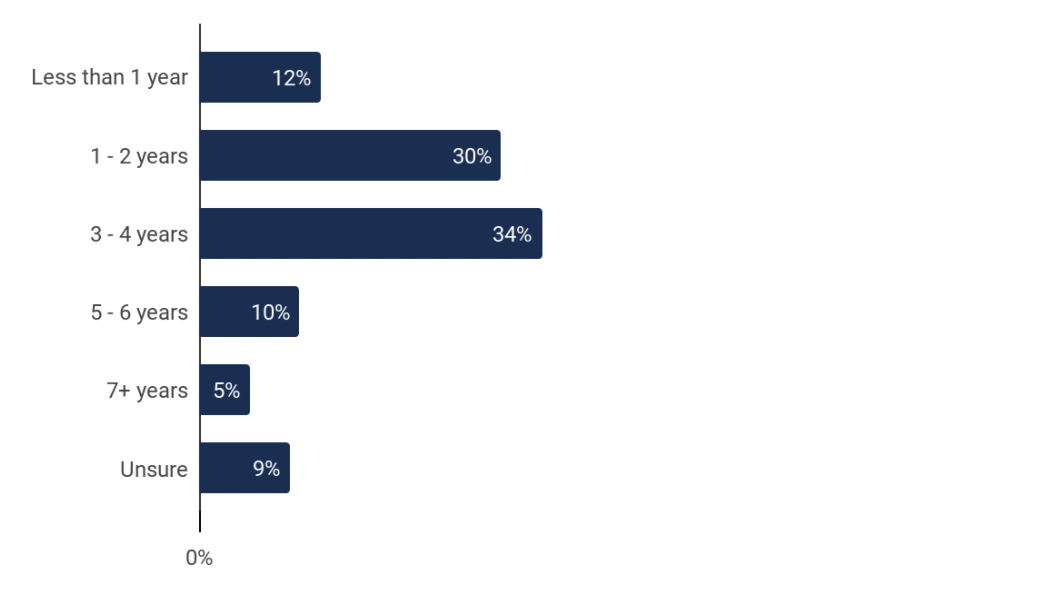
Automation has always been important, but, as mentioned, we’re seeing increased importance because of COVID-19. And, the reasons for automation are shifting as well. A study from Bain & Company shares why companies have been using automation prior to and during the pandemic:
“It’s no longer primarily about lowering costs. Companies are increasingly deploying automation to strengthen business resilience, reduce risk and generate useful business insights more easily.”
What this means for business leaders:
Organizations that are considering RPA are in a sweet spot right now: there is enough talent and expertise to help you get started, and the technology is a proven differentiator. If you are looking to get started with RPA, check out these ideas on what you can do to begin your journey effectively.
RPA is growing and developers are looking for new opportunities
Not only are Gartner and others predicting significant growth for RPA, but RPA developers are seeing this first-hand as well. Fully 92% of respondents think the RPA industry has a high potential for growth over the next five years, and 77% expect their organization will hire more RPA developers in the next 12 months (up from 70% last year).
A growing industry equals job opportunities—and RPA developers are well aware of this. They know they are in demand.
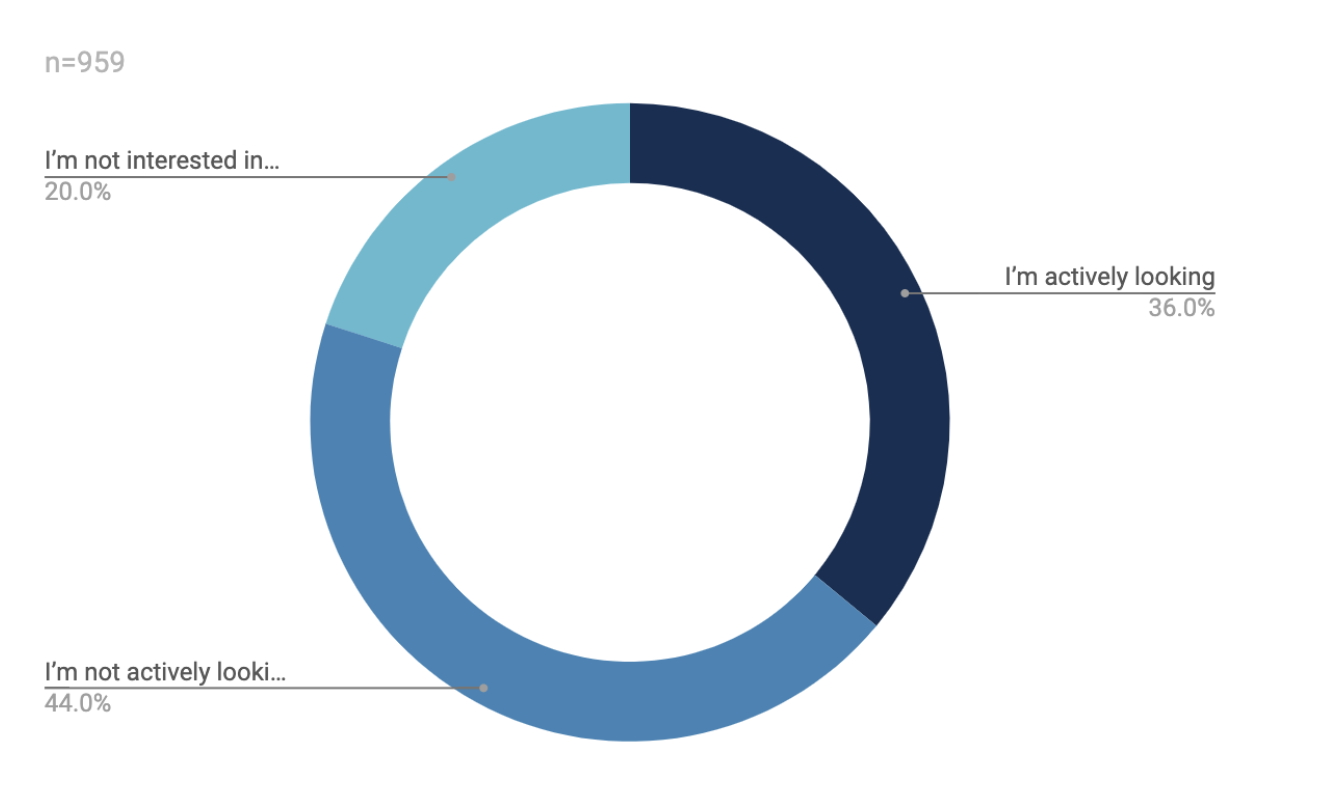
Even though RPA developers are, on the whole, happy with their jobs, 36% are actively looking for new jobs and an additional 44% aren’t actively looking but are open to new opportunities. Said another way: only 20% aren’t interested in a better opportunity.
What this means for business leaders:
If you want to retain top talent, you need to understand what makes RPA developers happy—and where they feel dissatisfied. Read on to get a better insight into both.
RPA developers want to increase salary and advance their careers
New this year, we dug in to better understand why developers who are open to a new job feel this way. Three reasons top the list:
Opportunity to advance career (78%)
Increased salary/compensation (78%)
Opportunity to learn new skills (76%)
And we looked at job satisfaction in another way, too: what factors are important to RPA developers and how satisfied are they in these areas? Looking at these gaps helps companies understand where they can be making adjustments regardless of their developers’ job-seeking status.
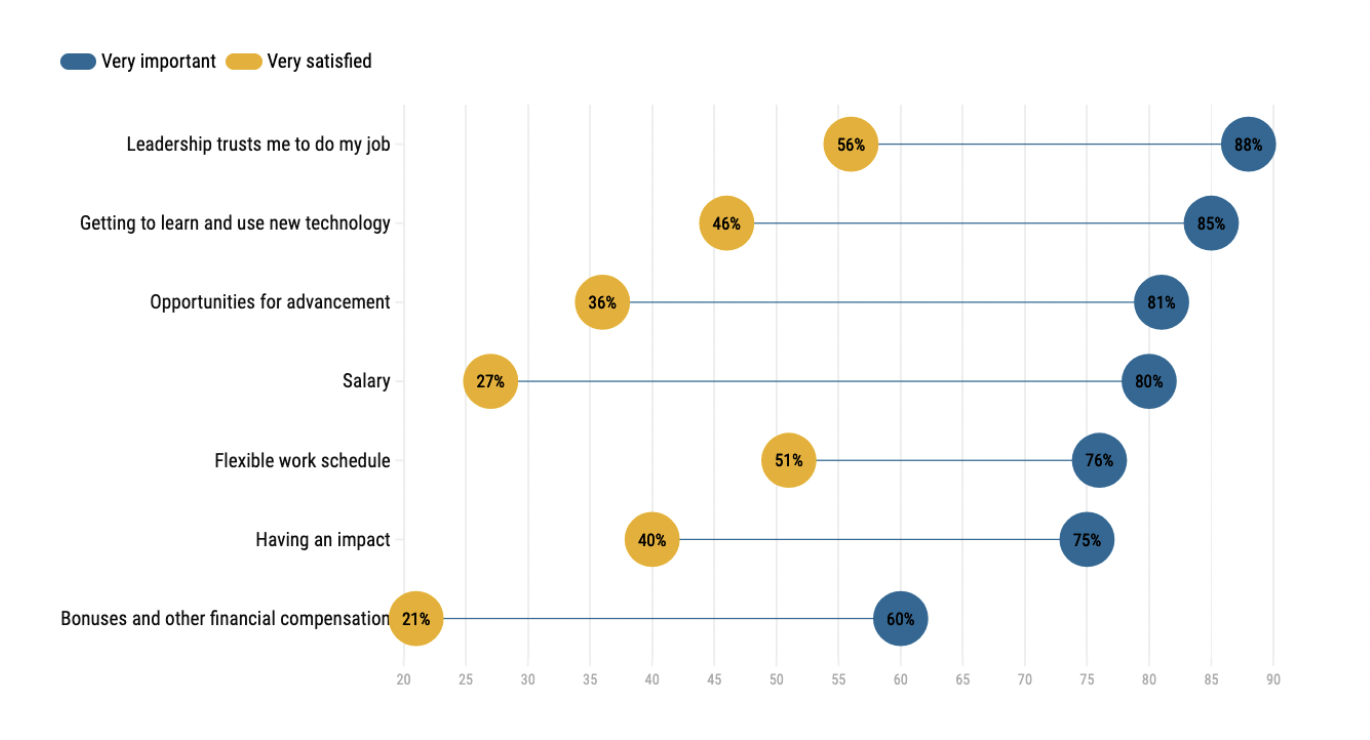
The biggest satisfaction gap exists with salary: 80% report this is very important, yet only 27% report being very satisfied.
While salary is important, it isn’t the only factor that impacts a developer’s happiness. As you can see again, developers are also interested in finding ways to advance and learning new technology.
What this means for business leaders:
If you are trying to retain or hire RPA developers, take this data to heart and make necessary adjustments. While we see the biggest gap with salary, there are many other things organizations can do to increase how valued a developer feels.
For instance, when asked why RPA is a good career choice, here's insight into what an ideal experience is like:
Automating business processes is great. I meet many people from our organization. By building various processes, I face various challenges. Every day is different and this is unique. Nothing is repetitive despite the fact that some solutions may be similar to each other. I am constantly developing and learning new solutions.
Adrian Starukiewicz, RPA Developer, Warta S.A.
RPA developers are working from home — and want to continue to do so
Like so many other professionals, RPA developers shifted the way they worked because of the pandemic. 86% reported they started working from home because of the pandemic, and 73% are still doing so.
This change of scenery has been welcome for many, with 90% reporting they would like to either continue working from home or work from a combination of home and the office.
However, working from home has not been without its challenges. Developers report they have been most challenged by the inability to unplug, collaboration, and distractions.
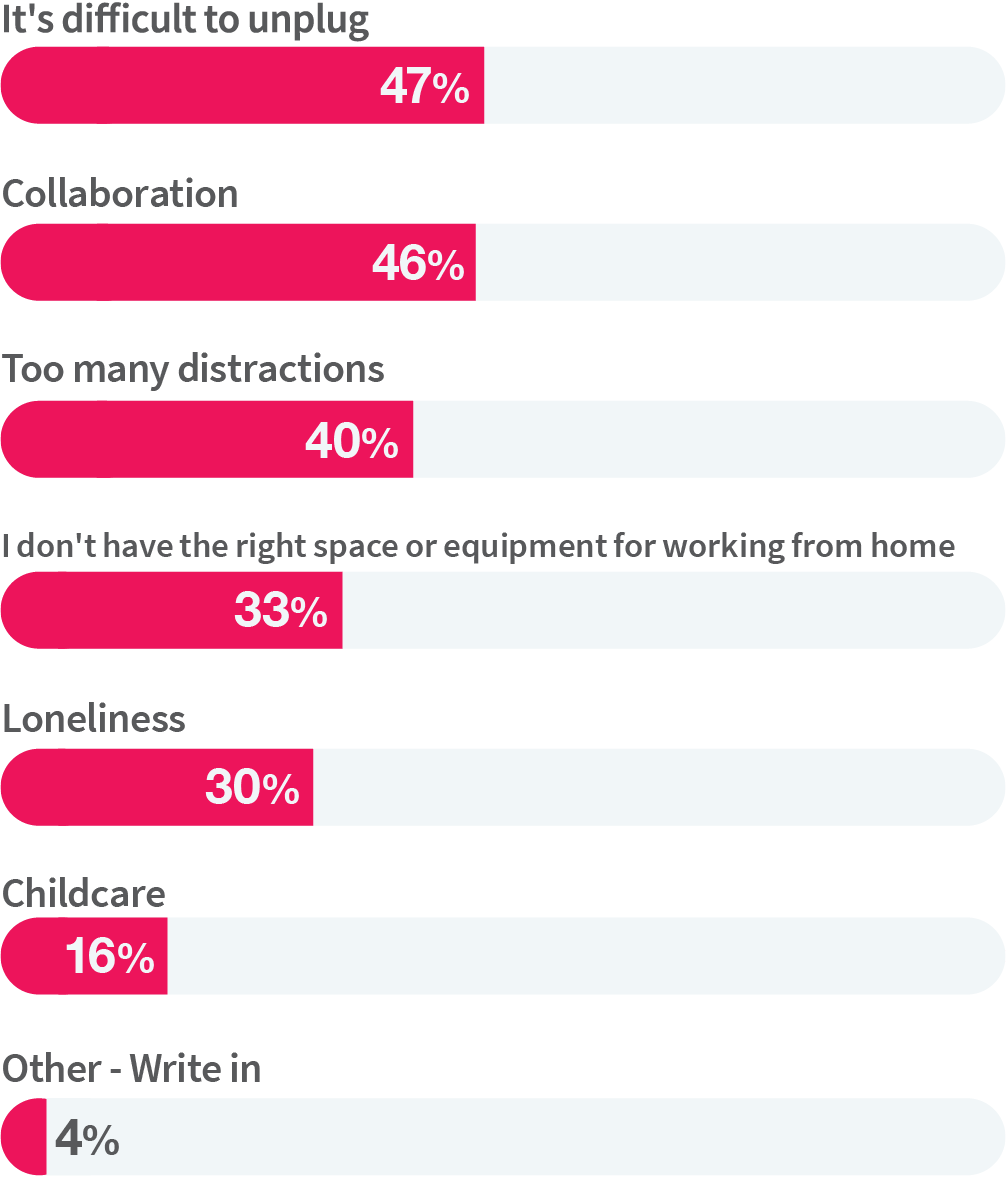
This echoes what Buffer uncovered with its annual State of Remote Work report. The biggest struggles facing those working remotely are difficulty unplugging, collaborating, and communicating.
What this means for business leaders:
Work from home is here to stay, at least in some capacity. If you haven’t already done so, shift the way you are interacting and collaborating with your team of developers so they feel connected.
Not to get too meta, but consider how RPA can help you automate some processes, too. For instance, you can improve how your team operates when working from home by sending out meeting minutes after a call, sending yourself your daily task list, or even streamlining your lunch order.
Get more ideas: How Enterprise Automation Makes Managing Remote Teams
Easier RPA is generating interest among developers from a variety of backgrounds
Even though RPA is an emerging field, it’s attracting interest from both new and experienced developers. Only one-third of RPA developers report this is their first professional role, while two-thirds have transitioned into this career from other roles.
RPA developers, while new to the field, aren't new to the workforce. Some 53% of RPA developers have at least five years of work experience and 30% have at least 11 years of experience.
While RPA developers are most likely to have a degree in engineering or computer science, 14% have degrees in business administration or finance/accounting. Comparatively, only 3% of respondents from Stack Overflow’s annual 2020 Developer Survey come from a business discipline.

When compared to other software development fields, RPA also has a higher percentage of women. In our survey this year, 20% of our respondents are women. This is also significantly higher than what Stack Overflow reports across all software developers: 92% of professional developers are male and 8% are female.
We also asked RPA developers if they think RPA is more diverse than other software development fields, and 59% agreed.
Even though RPA is a new industry, the field attracts both new and experienced professionals.
RPA is definitely for everyone. You can have it with no-code/low-code or you can dive into [it] in depth with any language you prefer.
Satish Reddy Patlolla, RPA Developer, Infrastructure Engineer and Administrator, Watts Water Technologies
What this means for business leaders:
RPA developers are a diverse group, and you’ll find candidates in areas you may not expect. The most common way developers found their most recent job was through an internal transfer (22%). Consider how you can find potential candidates among your existing employees.
RPA is an easy field to transition into
Regardless of how someone comes into RPA, our respondents report it was easy to transition into their role.
One likely reason for this is the ample education opportunities available. The chart below shares which education opportunities RPA developers are using and also indicates what they consider to be valuable. On average, developers are using four of these methods; only 1% said they hadn’t educated themselves using any of these.
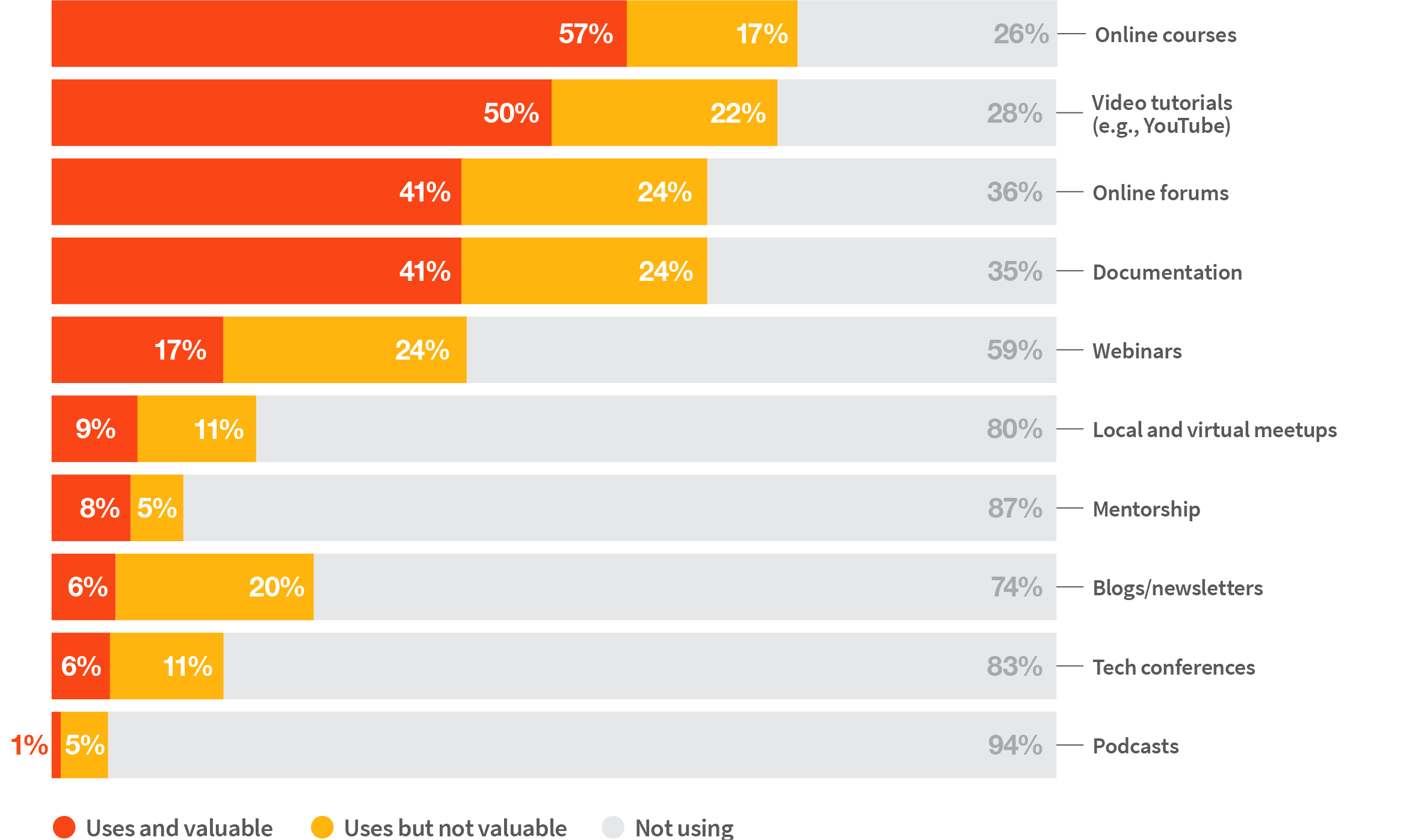
Online courses are the most common, with 77% of those using this method considering it to be valuable.
We also see a higher percentage of developers relying on video tutorials this year compared to last. We asked developers to share the names of their most admired RPA professionals; many of those named have YouTube channels through which they educate the community, including:
What this means for business leaders:
Encourage and financially support your developers with education. One popular path for many is to get a certification. Fifty-five percent of surveyed developers say they want to get the new UiPath Advanced RPA Developer Certification in the next month. As a leader, you can help support their career growth and build on their expertise by giving developers the support to prepare for the exam—and funding the exam itself.
Our prediction: RPA will continue to grow in importance for many organizations over the coming year, and it will become increasingly important to find the right developers for your project. Learn as much as you can about these developers and create a plan to hire and retain your top talent.
Want to see the full results from the State of the RPA Developer 2021? Download our PDF for all the findings.

(Previously) Director, Product Marketing, Community, UiPath
Get articles from automation experts in your inbox
SubscribeGet articles from automation experts in your inbox
Sign up today and we'll email you the newest articles every week.
Thank you for subscribing!
Thank you for subscribing! Each week, we'll send the best automation blog posts straight to your inbox.



